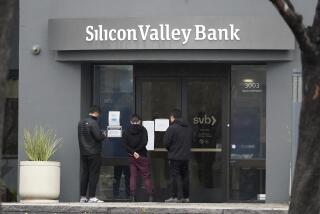Despite Setbacks, Criticism Imperial Sticks to Strategy : It Shifts Away From Traditional S&L; Business
- Share via
It would be difficult to find two more distinct visions of the savings-and-loan industry than those held by Golden West Financial Corp. Chairman Herbert M. Sandler and Imperial Corp. of America President Ken Thygerson.
Sandler, who has built Golden West’s Oakland-based World Savings & Loan subsidiary into a consistently profitable financial institution, is content to stick with what he once described as “residential lending--boring, dull, residential lending.”
San Diego-based ICA, which has been diversifying beyond the traditional S&L; business for the past three years into activities such as junk-bond investments and wholesale car and mobile home loans, has used new powers granted by regulators to move into what Thygerson once acknowledged as “strange and mysterious things” in the eyes of most industry executives.
Reasoning Behind Diversification
That diversification has been driven by Thygerson’s contention that a shrinking number of S&Ls; will be able to turn a profit from “going into the retail market and acquiring deposits and putting those deposits in home mortgages.”
Sandler, on the other hand, has voiced strong doubts about the ability of non-traditional institutions to safely navigate outside of the S&L; industry’s traditional businesses of attracting retail deposits and funding residential mortgages.
“The path to hell is strewn with the bodies of chief executives who have told me the exact same thing,” Sandler said when he and Thygerson squared off last September during an S&L; industry panel discussion at the Hotel del Coronado. “If you succeed, you’re going to be one of a very small handful, and I wish you the best of luck. . . . But most of us don’t have that kind of ability that we can operate (a S&L;) in a new way.”
Congress is now debating what powers S&Ls; will have in connection with a multibillion-dollar bailout of the financially troubled Federal Savings and Loan Insurance Corp., and it is too early to tell whether Sandler or Thygerson’s view will prevail.
But Thygerson has acknowledged that nearly 70% of the nation’s S&L; executives probably would support Sandler’s contention that regulators should institute stricter controls on S&Ls; that hold non-traditional assets--such as ICA’s $1.4-billion junk bond investment portfolio, which now represents more than 10% of ICA’s $12 billion in assets.
Stick to ‘Plain Vanilla’
And, he last week noted that many S&L; executives have expected him to “fall flat on my face” while diversifying beyond the traditional S&L; business of attracting retail deposits and funding residential mortgages.
Sandler’s contention that S&Ls; should stick to its “plain vanilla” business may have been bolstered in recent months after ICA created $109 million in reserves to cover anticipated losses in a problem-plagued consumer loan portfolio that since has been eliminated.
The reserves contributed to a fourth-quarter loss of $15.6 million and a slender first-quarter profit of $900,000. They also forced ICA to suspend its dividend payments.
Gary Gordon, a New York-based industry analyst with PaineWebber expects ICA to add $45 million to those reserves during 1989 to cover anticipated losses in the since-abandoned consumer loan portfolio.
Thygerson fueled rumors about ICA’s financial health during the company’s April 27 annual meeting by acknowledging that ICA would consider a merger as one way to raise the capital that S&Ls; will need to cope with tough requirements that Congress is considering in connection with its rescue of the financially troubled FSLIC.
Industry executives fear that a failure by ICA or another non-traditional institution would lead to heftier deposit insurance premiums that federal regulators collect to fund the FSLIC. Those executives also argue that high yields returned by non-traditional assets make it “very difficult for so-called traditional banks and S&Ls; to compete” for deposits, said Sandler.
“If it turns out that the high-yield assets weren’t the safest port, we’ll have another situation in which the marketplace was dislocated by the alleged insight of a few intelligent and perceptive individuals,” Sandler maintained during last September’s session in Coronado.
At the direction of the federal regulators, ICA in January took what Thygerson described as the “painful” steps of suspending its quarterly dividend and halting asset growth.
Despite ICA’s problems, federal regulators have not uncovered “even a shred of reason” to believe that Imperial Savings Assn. is likely to fail, Thygerson told shareholders during ICA’s recent annual meeting.
Defends Non-Traditional Approach
Consequently, Thygerson continues to defend ICA’s non-traditional approach to the S&L; business as a rational response to ever-narrowing profit margins faced by competitors in the traditional S&L; industry. “We’re aggressively looking for new, higher-yield markets to enter,” Thygerson said last week.
ICA is searching for those higher-yield markets because of the “fallacy that what’s good for (a traditional institution) and its shareholders must be good for the entire industry,” Thygerson said. “That’s something of a Catch 22 because the (profit) margins (on traditional home lending) are simply not going to get better.”
Although Thygerson has acknowledged that Congress could ease Sandler’s concern by “eliminating my (non-traditional) powers,” he also has maintained that non-traditional S&Ls; won’t simply disappear if the industry is re-regulated.
Rather, Congress eventually will loosen restrictions and allow S&Ls; to once again venture into non-traditional businesses, Thygerson predicted. “We’ll just come back in another form,” Thygerson told Sandler. “Maybe it won’t be my face, maybe it won’t be my institution, but we’ll get you anyway.”
The reserves taken so far will cover as-yet undetermined losses generated by a fraud-ridden loan portfolio that ICA purchased from Glendora-based Grand Wilshire Finance Corp., which since has entered Chapter 11 bankruptcy proceedings. They also will cover anticipated losses from a defaulted business loan made to Global Motors, the U.S. distributor for Yugo automobiles, and for anticipated losses in ICA’s credit card and mobile home portfolios.
Thygerson has acknowledged that the reserves have hurt ICA. Since the announcements, its stock price has tumbled to $5.375 from a 52-week high of $9.125.
The stock drop, however, has not changed Thygerson’s outlook. In moving away from traditional S&L; businesses, he intends to continue to depend on the high-yield corporate bond business that has been a favorite target of ICA’s critics.
“We didn’t (stumble) in our junk bond portfolio,” said Thygerson, who has consistently defended the high-yield portfolio.
However, in response to pressure from state and federal regulators, ICA has set aside $24 million in reserves in connection with the $1.4-billion junk bond portfolio. That represented a slight increase in reserves from the provision last year, according to Thygerson.
‘Certain Risks’
ICA also has taken steps to reduce the “certain risks associated with investments in high-yield bonds,” according to the company’s most recent 10-K filing with the Securities and Exchange Commission. ICA has invested no more than 5% of its junk bond portfolio in a single junk bond issue. No single ICA investment accounts for more than 10% of a single issue, and ICA does not invest more than 15% of its portfolio in any one industry.
Fueled in part by that successful junk bond portfolio, ICA reported a 28.6% return on equity during 1986 and a 22.7% return during 1987. However, ICA’s return on equity fell to 5.5% during 1988. Thygerson acknowledged that ICA must return to a return of 15% or better in coming years if the company is to remain attractive to shareholders.
Although many industry executives are outright hostile toward ICA, industry analysts generally have remained lukewarm on ICA’s stock. PaineWebber’s Gordon, for example, recently upgraded his rating unattractive to neutral.
“We believe management has a sound operating plan to improve profit margins and grow capital,” according to Gordon. “Imperial should generate positive operating earnings this year of about $.40 per share and a sharp increase in operating earnings next year to $1.50 per share, despite its auto loan problem and capital constraints.”
Analysts have not, however, suggested that ICA’s recent loan problems--particularly those involving Glendora-based Grand Wilshire--signal a negative trend. With Grand Wilshire, ICA was “defrauded, and they weren’t alone,” observed David Hochstim, a New York-based analyst with Bear Stearns & Co. “The loans were consistent with their strategy, but (ICA) got bagged, along with a lot of other people.”
Still, ICA’s problems with its consumer lending portfolio were magnified because, “like with any fully leveraged business, if you make a mistake, it’s going to become a bigger one,” said Allan G. Bortel, a San Francisco-based analyst with Shearson Lehman Hutton.
Stricter Requirements
ICA also has begun searching for capital to meet stricter capital requirements that will be mandated as part of the Congressional “fix” for the Federal Savings and Loan Insurance Corp.
Thygerson created a stir at ICA’s annual meeting when he acknowledged that ICA has held preliminary--but inconclusive-- discussions with possible merger partners.
However, Thygerson last week downplayed the possibility of a merger, noting that ICA “probably could meet the capital requirements” included in the House of Representatives’ latest version of a bill designed to deal with the crisis facing savings institutions.
More to Read
Inside the business of entertainment
The Wide Shot brings you news, analysis and insights on everything from streaming wars to production — and what it all means for the future.
You may occasionally receive promotional content from the Los Angeles Times.










